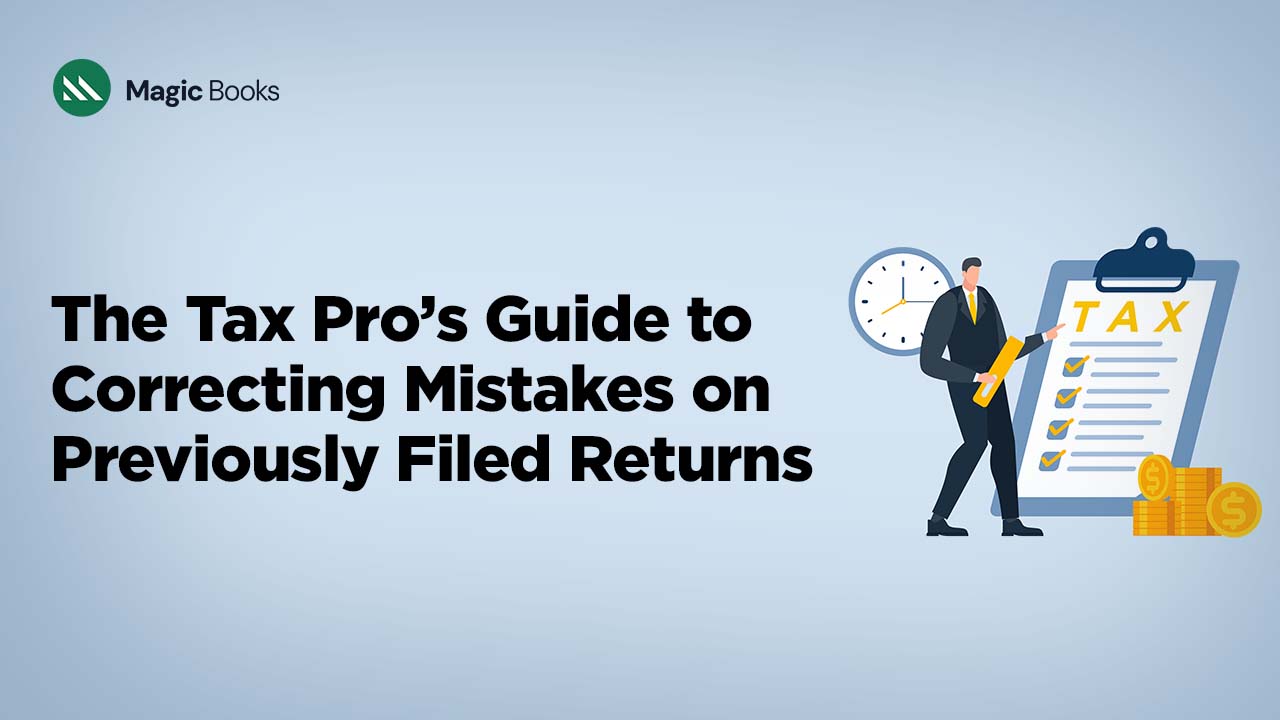A few weeks after the tax season finished, a financial planner at a midsized company was going over files when she caught a $15,000 omitted charitable donation on her client’s return. She shivered—she knew that even small errors can snowball rapidly, especially when clients expect you to be pro-active champions of their interests. She corrected it immediately, with full disclosure to the client before the IRS ever had a chance.
The advisor’s urgency was well warranted. Submitting a flawed return puts clients at risk of underpayment penalties, unpaid-balance interest, and worst-case scenario, lengthy IRS audits that can last months. Internal Revenue Code §6651 imposes stiff penalties on late payment and late filing. For tax pros, even an honest mistake can harm their professional reputation with established clients and referral sources. But most tax mistakes, if detected early, are easily fixed with minimal inconvenience—but the clock starts running when the return is e-filed or mailed, so speed and openness are critical considerations.
Finding the Error—Where to Start:
Mistakes usually go unnoticed in the initial look: a misplaced Social Security number; a forgotten 1099 amidst a busy February; credits not posted as a supporting schedule didn’t import. Consider Jenna, a conscientious bookkeeper, who discovered she’d posted a client’s consulting income as $5,930 instead of $9,530—a misplaced digit. The mistake wasn’t discovered until an IRS “Math Error Notice” arrived, highlighting the deviation.
IRS Publication 630 outlines the agency’s routine practice of automatically correcting apparent arithmetic mistakes, but requiring the filers to correct their own miscalculated or missing items. Catching red flags—such as mismatched W-2s or missing dependents—is important, but perhaps equally crucial is the detection of more insidious issues, such as stale address listings or erroneous quarterly estimates.
Choosing the Right Mode of Amendment:
All errors are not created equal—no more than all corrections are created equal. For most individual tax returns, Form 1040-X is the first line of preference; however, business organization amendments have their own paths: corporations utilize Form 1120-X, partnerships utilize Form 1065-X, and so on. In general, this 1040-X can only be utilized for original Forms 1040, 1040-SR, or 1040-NR.
The timing, too, is tightly regulated—typically, you have to make an amendment within three years of the early filing deadline or two years from when you paid the tax due, whichever is later. There are exceptions, including loss carrybacks and bad debt, but most simple corrections follow the three-year rule.
Step-by-Step Procedure to File Form 1040-X
It’s not rocket science to prepare Form 1040-X for a professional, but accuracy counts. The form is structured around three columns: original return numbers, the corrections, and the corrected numbers.
Column A reflects the amounts as filed; Column B indicates the net decrease or increase; and Column C reflects the adjusted totals.
Assume a client adds a missed $2,500 education credit. The explanation area—usually sloppy—must recount the rationale for each change: “Taxpayer omitted Form 1098-T. Amending to take American Opportunity Credit, as evidenced by attached documentation.” Don’t use boilerplate language. Including all attachments (W-2s, corrected 1099s, amended schedules) explicitly mentioned here saves several weeks of IRS inquiries and minimizes the likelihood of follow-up requests
Common Missteps and How to Steer Clear:
One advisor recalls taking months to process a 2022 amendment—one for a missed student loan interest deduction—because of a misplaced mention of Schedule 1, Line 8, instead of Line 21. The IRS returned the amendment with a brusque request for clarification and tacked on unnecessary weeks to the fix.
Another frequent mistake is not including critical supporting schedules. For instance, if there is a modification of Schedule C business income, the revised (new) Schedule C should be attached to Form 1040-X. The IRS instructions emphasize that all supporting schedules and forms required in the “Explanation of Changes” should be attached properly, either amended e-filed or sent by mail. Cross-checking form numbers and lines is worth it in streamlined processing.
Beyond Individual Returns—Business Amendments:
For business clients, things turn around fast. Corporations fix their errors with Form 1120-X, while partnerships typically resort to Form 1065-X or file an Administrative Adjustment Request (AAR) if they are subject to the centralized partnership audit regime. Each method has varying timing and notice requirements.
Take this scenario: S-Corp’s accountant discovered that a wrong quarterly estimated tax payment was left out of the original Form 1120-S. Both the federal return and state returns had to be amended since each has its own amendment process and due date. Treasury regulations and industry commentary observe that for large pass-throughs, even small errors can necessitate coordinated, multi-jurisdictional effort.
Electronic vs. Paper Filing—Advantages and Disadvantages
In 2020, the IRS caused a stir by opening e-filing of Form 1040-X for the very first time. This was a welcome change for practitioners: e-filed amended returns are typically processed faster and provide tracking features similar to original e-filed returns. Still, some forms—specifically, those involving business entities—are exclusively paper-based, leading to processing times of more than 16 weeks during busy times.
E-filing also assists in minimizing human data-entry errors by IRS personnel, possibly reducing audit flags. With that in mind, the pace of e-adoption continues to be uneven, with IRS system backlogs sometimes necessitating even e-filed amendments to withstand extended holding patterns, particularly in instances of significant policy changes or personnel shortages. Client expectations should be managed in advance for average turnaround times.
Speaking with Your Client:
One of the most anxiety-provoking calls a client will ever get? A “We found something on your tax return” letter. Transparency, not alarm, is the goal. A template example:
| Dear [Client Name],In our recent review, we found something on your recently submitted tax return that must be corrected. This is not uncommon, and we have outlined the steps below that must be taken. It generally takes the IRS 8 to 16 weeks to correct these, and we will closely monitor the status until all is said and done.We will be in contact with further information and are pleased to respond to any questions concerning fees or timetables. |
Open and honest communication builds trust with the client, especially when extra charges or document requests arise along the way.
Post Submission—Tracking and Follow-Up:
After one files an amended return, the job is not done. The IRS also has the “Where’s My Amended Return?” portal, a unique tool for monitoring Form 1040-X status. Clients find timely notification helpful: the portal indicates whether the amendment is received, in progress, or finished. Practitioners in most instances note movement within three weeks, with completion within 8–16 weeks, though paper filings push these limits.
Other than the watchful eye of the IRS, good practice dictates that both versions—original and amended—be stored in the client’s electronic filing system. A good document policy not only simplifies reviews in the future but also keeps advisors one step ahead in case questions are raised years down the line.
Best Practices to Avoid Future Errors:
Accuracy in tax returns is the foundation of professional integrity. In today’s digital-first world, the methods employed by leading advisory firms as well as sole practitioners have evolved to be more methodical approaches—leveraging technology and a culture of collaboration.
- Systematic Record-keeping and Real-time Documentation:
Errors frequently occur due to gaps in documentation or the tendency to wait until filing season to organize records. Successful businesses today stress the importance of real-time recordkeeping and invite clients to submit source documents throughout the year—not only at tax time. It guarantees that income, deductions, and credits have supporting timely records. B2B firms frequently use cloud-based systems to gather W-2s, 1099s, invoices, and receipts as they are created. Solo advisors can achieve the same result by employing mobile-app scanners or client portals.
Maintaining and keeping prior returns, substantiating documentation, and correspondence electronically protects against future controversy and allows for a simple audit trail. A well-organized electronic archive can be a worthwhile asset when making changes to prior returns or answering IRS questions.
- Standardised internal reviewing processes and quality assurance:
A proper internal review process remains the gold standard. Most companies have adopted complete checklists or workflow management systems where line-by-line review of all data points, cross-checking key financial reports like Form 26AS, AIS, and TIS with reported numbers is undertaken. The best practices identify a different reviewer from the preparer who is supposed to challenge assumptions, verify key data, and verify filing deadlines and e-signatures.
Critical aspects of quality control are:
Multi-level review: Managerial or peer review of all returns prior to filing.
E-filing software provides an automatic validation process, highlighting errors and ensuring that all schedules and forms are incorporated. Leveraging pre-filled data from government portals, it notably reduces the incidence of manual input errors.
Step-by-step checklists: Utilizing process-oriented, step-by-step checklists for B2B and B2C returns that assist in monitoring every filing and amendment step from document procurement through final proofreading.
- Continuing Professional Development and Interaction:
Tax laws change every year. Boutique offices spend money on quarterly employee training and weekly newsletters or IRS notices, for example. For smaller-sized offices, membership in professional discussion groups or webinars keeps them current. The effort is worth it—recent research indicates that firms with continuous training experience error rates decrease by up to 35%.
Clear and consistent communication within a business is very critical. For instance, debriefing on past errors on a regular basis and going over any notices from the IRS or state agencies makes every error an incredibly valuable learning opportunity, thus reducing future risk.
- Active use of IRS and third-party tools:
Practices that make frequent use of IRS publications, computer whizzes, and pre-filing check utilities are good at detecting issues early on. The IRS e-filing systems, with their embedded error detection functions, can detect mismatches before filing a return, thereby decreasing the likelihood of adjusting later. Moreover, most professionals recommend that clients check Form 26AS, AIS, and TIS each year to confirm all income reported is properly reflected, especially since banks are in the habit of sending updates near the end of the year.
- Pre-season “Dry Runs” and Post-filing Retrospective Reviews
Leading B2B companies like to run test “dry runs” prior to busy-season tax season:
Preparers practice mock returns, simulating casework based on intricate client scenarios to identify potential workflow bottlenecks or knowledge gaps beforehand. Post-filing season, after-action reviews of mandatory changes and IRS notices provide a root-cause analysis, generating actionable intelligence for the next cycle.
| Best Practice Category | B2B (Large Firms) | B2C (Solo/Small) |
| Recordkeeping | Cloud-based portals, automated uploads | Mobile scanner apps, Dropbox/Google Drive |
| Review Process | Multi-person, manager-based review | Peer review or preparer self-audit |
| Technology Use | Enterprise e-filing & workflow tools | Commercial tax software |
| Staff Training | Quarterly mandatory workshops | Webinars, industry newsletters |
| Error Analysis | Post-season root-cause meetings, amendment tracking | End-of-season checklist and self-review |
Adapting Protocols to Suit Practice Size and Client Type: Larger firms segment workflow into chunks: preparers, reviewers, and client relationship managers are checkpoints. Detailed process guides—issued yearly—regulate team work. Boutique firms or single advisors, on the other hand, can use straightforward checklists and workflow software to introduce consistency and accountability. By emphasizing modern best practices—such as rigorous internal controls, clever exploitation of technology, and a progressive learning environment—we can dramatically reduce the prevalence and severity of tax return errors. Whether navigating the complexities of a multinational company or the nuances of a freelancer’s return, the principles are the same: systematization, vigilance, and an emphasis on continuous improvement.



